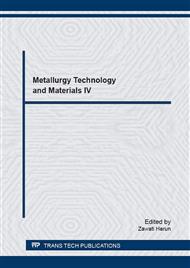p.98
p.103
p.111
p.116
p.121
p.127
p.132
p.139
p.147
Preparation of Coated Type Al-Al2O3 Cermet Composite Powders via the Calcination Oxidation Method
Abstract:
Cermet while maintaining the excellent properties of ceramic materials, but also have the advantages of a metal material, is an important new engineering materials. In this paper, prepared by calcination of alumina - aluminum metal-ceramic composite material powder, and its characterization as a basis to provide raw materials for preparing high performance metal ceramic material. According to the research, with the calcination temperature is increased, the rate of change gradually increase the weight of aluminum. Calcined at a temperature of 600¡æ, the oxidation of aluminum surface the best. With the firing time increases, the rate of change in the weight of aluminum powder showed an increasing trend. When 8h, oxidation of aluminum surface better. Through this experiment, process optimization can be found in the calcination temperature was 600¡æ, calcination time is 8h, the best coating effect aluminum surface, coating evenly, clean interface, the reaction layer thickness of about 700nm, the prepared package type composite powders the best results.
Info:
Periodical:
Pages:
121-124
Citation:
Online since:
August 2016
Price:
Сopyright:
© 2016 Trans Tech Publications Ltd. All Rights Reserved
Share:
Citation:


